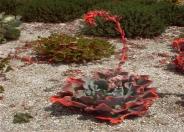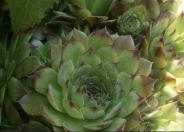
Common name:Carpet Echeveria
Botanical name:Echeveria agavoides
This attractive succulent has fleshy leaves that form rosettes, with an overall diameter of 12". Foliage is apple green color with a terminal spine and reddish margins. Flower stalks rise up from the center in spring and summer with tiny red and yellow flowers. This plant tolerates full to part sun and needs well draining, dry, well draining, sandy or rocky soil. Beautiful in containers and rock gardens. Great for a Southwest or desert themed garden.

Common name:Red Edge Echeveria
Botanical name:Echeveria subrigida
This attractive succulent is an evergreen that quickly reaches 18" tall and 36" wide. Leaves are thick, long and oval, blue green with a thin pink margin. Leaves form a rosette. From spring through summer, 12" tall spikes rise from the center of the rosettes, with blue colored buds changing to coral, tubular flowers. This plant does well in full sun in coastal areas but appreciates afternoon shade in warm, inland areas. It needs well draining soil. It is drought tolerant once it's established.

Common name:Carpet Echeveria
Botanical name:Echeveria agavoides
This attractive succulent has fleshy leaves that form rosettes, with an overall diameter of 12". Foliage is apple green color with a terminal spine and reddish margins. Flower stalks rise up from the center in spring and summer with tiny red and yellow flowers. This plant tolerates full to part sun and needs well draining, dry, well draining, sandy or rocky soil. Beautiful in containers and rock gardens. Great for a Southwest or desert themed garden.

Common name:Hens and chicks, houseleek, roof ho
Botanical name:Sempervivum tectorum
Sempervivum tectorum is a low-growing evergreen succulent that looks a little like rubbery roses with thick, fleshy pads arranged in rosettes. The leaves are usually pointed and some have purple tips or they may grow in shades of red. They are considered alpine or rock garden plants, because of their hardiness and drought resistance. The original hen rosette produces tiny rosette offsets known as the chicks. They are slow-growing plants, and they remain evergreen throughout the year, even in cold climates. Mature plants produce an odd-looking thick flower stalk with star-shaped flowers at the tip of mauve-pink or red. These are not tall plants, except when they stretch out to flower. The flower stalk extends 8 to 12 inches before flowering, then reduces in size once the plant blooms and the mother plant dies. Hens and chicks are not grown for their flowers, but when they do bloom, it is usually during the summer. Plant them in late spring, when there's no longer a chance of frost and it's still not too hot outside. Planting a large patch, using them along edges, or mixing them in a container garden will help them stand out. Another option is to mix hens and chicks with creeping sedum which can make a lawn alternative where there is no foot traffic. If you have a rock garden or rock wall, you have the perfect environment for growing hens and chicks. Tuck them into the crevices or let them drape over a rock wall. Stone provides the perfect balance of drainage, radiant heat, and root protection. Hens and chicks will spread by underground roots. During the growing season, expect each plant to multiply itself by at least four, by producing little offset plantlets all around the perimeter of the hen. These chicks can be snapped off and replanted elsewhere at any time. Once established, the maintenance of hens and chicks is minimal. You’ll need to remove the old hens, after they flower, and divide chicks as needed. They are tough plants that survive just about any condition, even frost and cold. Hens and chicks prefer a spot in full sun but will appreciate some afternoon shade if planted in extremely hot climates. Hens and chicks, as with most succulents, need excellent drainage. Poor, sandy soil would be just fine. You could work some peat into heavier soil, to lighten it and improve drainage. Soil pH should be in the neutral range, 6.6 to 7.5. Except in extremely hot, dry situations, you won’t need to give this plant any supplemental water. They prefer an average climate between 65 and 75 degrees Fahrenheit. If temperatures drop too low, they will not necessarily die off but will stop growing and go into a semi-dormant state. No fertilizer is needed.

Common name:Hens and Chicks
Botanical name:Echeveria 'Imbricata'
This succulent perennial is very small, growing only 2-3" high. It produces orange, pink, and red blooms and does best in full sun and moist soil.

Common name:Afterglow Echeveria
Botanical name:Echeveria 'Afterglow'
This succulent perennial is very small, growing only 2"-3" high. It does best in full or partial sun and well draining soil. Established plants need little water but will do better with additional water during hot spells. Attracts hummingbirds. Tolerates coastal conditions. Orange flowers bloom in summer. Foliage is outstanding with lavender pink-tinged leaves.

Common name:Catalina Live-Forever
Botanical name:Dudleya hassei
Dudleya hassei is a succulent ground cover with gray, finger-like, swollen leaves that only reaches 6" tall but may spread several feet. Long vertical stems appear in spring, with white flowers. Hummingbirds love this plant. It does best in coastal areas in full sun and infrequent but deep irrigation. It prefers sandy, well draining soil. This plant looks great in containers and around rock outcroppings.
Designer: Sherman Library and Gardens
Photographer: Anne Chilcott
Maintain a two to four inch layer of mulch on the soil surface to reduce weeds, infiltrate rain water, and reduce compaction.
Remove irrigation water and fertilizer from areas where you don't want weeds to grow.